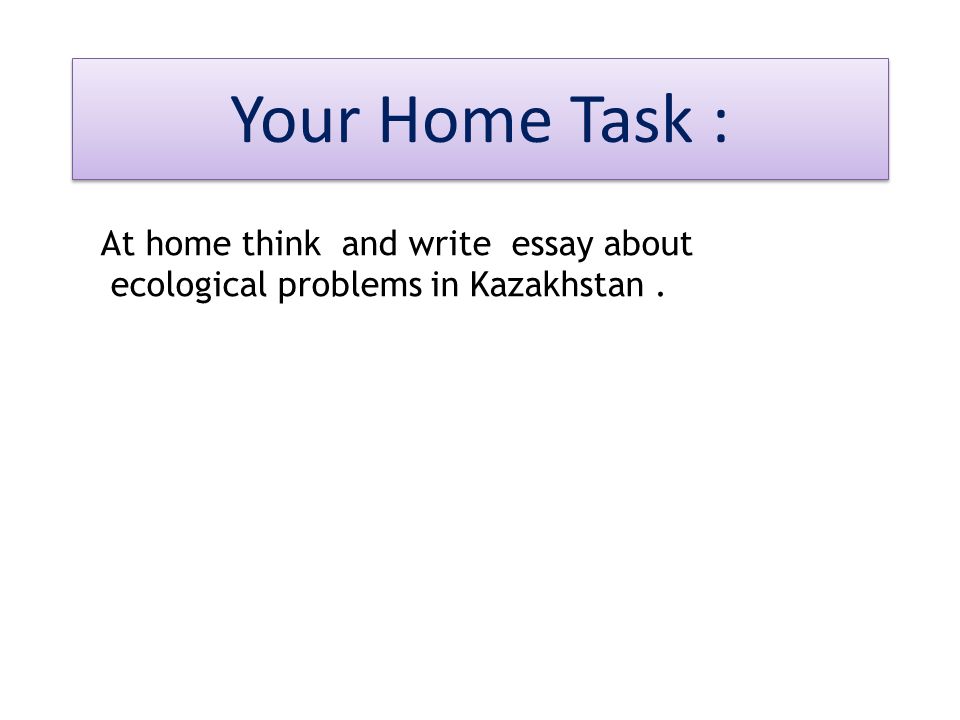Ecological Problems Of Kazakhstan Essay
- 11 Comments!

Ecological problems of kazakhstan essay writing. Ecological problems of kazakhstan essay writing. 5 stars based on 40 reviews.
ENVIRONMENTAL ISSUES IN KAZAKHSTAN The Soviets regarded Kazakhstan as a convenient place to test nuclear and biological weapons and locate polluting industries. Radioactive or toxic chemical sites associated with former defense industries and test ranges scattered throughout the country pose health risks for humans and animals.
Industrial pollution is severe in some cities. Pollution in the Caspian Sea is also a problem. Soil pollution from overuse of agricultural chemicals and salination from poor infrastructure and wasteful irrigation practices. [Source: CIA World Factbook =] Most of Kazakhstan’s water supply has been polluted by industrial and agricultural runoff and, in some places, radioactivity. Environmental geology edward keller pdf viewer.
Desertification has eliminated substantial tracts of agricultural land. Plants in industrial centers lack controls on effluents into the air and water. The Semey region in the northeast has long-term radiation contamination from Soviet-era weapons testing. The Ministry of Environmental Protection is underfunded and given low priority. Some new environmental regulation of the oil industry began in 2003, but expanding oil operations on Kazakhstan’s Caspian coast add to that sea’s already grave pollution.
International programs to save the Aral and Caspian seas have not received meaningful cooperation from Kazakhstan or other member nations. [Source: Library of Congress, December, 2006 **] The Aral Sea, which is shared with Uzbekistan, has shrunk to three separate bodies of water. Because the two main rivers that flowed into the Aral Sea have been diverted for irrigation, it is drying up and leaving behind a harmful layer of chemical pesticides and natural salts; these substances are then picked up by the wind and blown into noxious dust storms; A Soviet-era biological weapons site is a threat because it is located on a former island in the Aral Sea that is now connected with the mainland. The reduction in the Aral Sea’s water surface has exacerbated regional climatic extremes, and agricultural soil has been damaged by salt deposits and eroded by wind. ** = Environmental international agreements: party to: Air Pollution, Biodiversity, Climate Change, Desertification, Endangered Species, Environmental Modification, Hazardous Wastes, Ozone Layer Protection, Ship Pollution, Wetlands; signed, but not ratified: Climate Change-Kyoto Protocol. = Carbon dioxide emissions from consumption of energy: 224.2 million Mt (2012 est.), country comparison to the world: 28. = Pollution in Kazakhstan Industrial pollution is a concern in Kazakhstan's manufacturing cities, where aging factories pump huge quantities of unfiltered pollutants into the air and groundwater.
Almaty, is particularly threatened, in part because of the postindependence boom in private automobile ownership. [Source: Library of Congress, March 1996 *] There is air pollution from iron and steel factories and industries that use low-grade coal. Plants in industrial centers lack controls on effluents into the air and water.
Zinc and lead smelters and uranium processing plants have polluted cities in eastern Kazakhstan. In some big cities and industrial centers concentrations of some toxic substances, such as heavy metal dust, sulfur dioxide, carbon oxide, and some others, exceed maximum permissible concentrations (MPC) greater by more than tens of time. The most acute situations are in the cities of Taraz, Temirtau, Almaty, Oskemen, Leninogor, Shymkent and Balkash. Pollutant concentrations in these cities are five to ten times greater than MPC limits. [Source: Alia S. Beisenova Abay Kazakh National Pedagogical University, 2010] The air in the regions, where mineral resources are exploited is significantly polluted. Pollution is also caused by rockets launching at the Baikonur space center.

Industrial pollution is aggravated by large-scale chemical pollution caused by agriculture. Various chemical used for plant protection, defoliants, pesticides, and fertilizers pollute both the environmental and food. [Ibid] Tengiz Oil Field Pollution Oil pumped from Tengiz Field contains high levels of hydrogen sulfide. Processing it generates huge pools of blood red sulfur that dries into 11-meter tall yellow slabs that are stacked neatly and sold to chemical companies and other buyers.
As of 2001, about 4.4 million tons of sulfur had been produced. Exxon and Chevron, who have a 75 percent stake in Tengiz, insist the sulfur doesn’t cause any long term health problems. Environmentalist disagree. They say that workers at the field and people that live in the area have unusually high mortality rates.